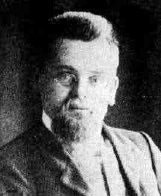

Ernst Zermelo's father was a college professor, so Zermelo was brought up in a family where academic pursuits were encouraged. He graduated from gymnasium in 1889. At this time it was the custom for students in Germany to study at a number of different universities, and that is what Zermelo did. He studied at Berlin, Halle and Freiburg, and the subjects he studied were quite wide ranging and included mathematics, physics and philosophy.
At these universities he attended courses by Frobenius, Lazarus, Fuchs, Planck, Schmidt, and Schwarz. Zermelo began to undertake research in mathematics after completing his first degree. His doctorate was completed in 1894 when the
University of Berlin awarded him the degree for a dissertation on the
calculus of variations. In this thesis he extended Weierstrass's method for the extrema of integrals over a class of curves to the case of integrands depending on derivatives of
arbitrarily high order, at the same time giving a careful definition of the notion of neighbourhood in the space of curves.
After the award of his doctorate, Zermelo remained at the University of Berlin where he was appointed assistant to Planck who held the chair of theoretical
physics there. At this stage Zermelo's work was turning more towards areas of applied mathematics and, under Planck's guidance, he began to work for his
habilitation thesis studying hydrodynamics.
In 1897 Zermelo went to Göttingen, the leading centre for mathematical research in the world at that time, where he completed his habilitation in 1899. Immediately following the award
of the degree he was appointed as a lecturer at Göttingen on the strength of his contributions to statistical mechanics as well as to the calculus of variations.
The direction of Zermelo's research was soon to take a major change. Cantor had put forward the continuum hypothesis in 1878, conjecturing that every
infinite subset of the continuum is either countable or has the cardinality of the continuum.
Zermelo began to work on the problems of set theory, in particular taking up Hilbert's idea to head towards a resolution of the problem of the continuum
hypothesis. In 1902, Zermelo published his first work on set theory, which was on the addition of transfinite cardinals. Two years later, he succeeded
in taking the first step suggested by Hilbert towards the continuum hypothesis when he proved that every set can be well ordered. This result brought fame to
Zermelo and also earned him a quick promotion to professor.
His proof of the well ordering property used the axiom of choice to construct sets by transfinite induction. The proof stirred the mathematical world and produced a great deal of criticism - most of it unjustified. Zermelo's reaction to these criticisms was to try to prove the well ordering property with a proof that would find more widespread
acceptance, and this he succeeded in doing in 1908.
Zermelo made other fundamental contributions to axiomatic set theory which were partly a consequence of the criticism of his first major contribution to the
subject, and partly because set theory began to become an important research topic at Göttingen. The set theory paradoxes first appeared around 1903 with the
publication of Russell's paradox. This prompted him to make
the first attempt to axiomize set theory and he began this task in 1905. Having produced an axiom system he wanted to prove that his axioms were
consistent before publishing the work, but he failed to achieve this.
In 1908, Zermelo published his axiomatic system containing 7 axioms despite his failure to prove consistency. Zermelo usually stated his axioms and theorems in words rather than symbols.
Skolem and Fraenkel independently improved Zermelo's axiom system in around 1922. The resulting system, with 10 axioms, is
now the most commonly used one for axiomatic set theory. It enables the contradictions of set theory to be eliminated yet the the results of classical set theory
excluding the paradoxes can be derived.
In 1910 Zermelo left Göttingen when he was appointed to the chair of mathematics at the Zurich University. His health was poor but his position was helped
by the award of a prize of 5000 marks for his major contributions to set theory.
When his health had not improved by 1916, Zermelo resigned his chair in Zurich and moved to the Black Forest in Germany where he lived for 10 years. He
was appointed to an honorary chair at Freiburg im Breisgau in 1926, but he renounced his chair in 1935 because of his disapproval of Hitler's regime. At the
end of the World War II Zermelo requested that he be reinstated to his honorary position in Freiburg, and indeed he was reinstated to the post in 1946.